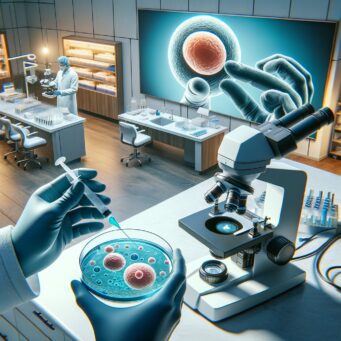
One of the most unusual news stories of 2017 was that a Tennessee couple had a healthy baby in November using the longest known frozen human embryo to result in a successful birth. This was possible through an embryo donation that was originally frozen on October 14, 1992.
How was that even possible?
While the majority of frozen embryos are intended for use by the couples who create them in IVF treatment cycles (either if the first cycle is not successful or if they want additional children), there are thousands that go unused and are potentially available for embryo donation.
People pursuing alternative paths to creating a family might consider using donated embryos.
Is it Embryo Adoption or Embryo Donation?
Two terms are used for this kind of embryo sharing: embryo donation and embryo adoption. Here are two perspectives:
According to Kimberly Tyson, Marketing and Program Director of Nightlight Christian Adoptions/Snowflakes Embryo Adoption, the organization believes that life begins at conception.
Tyson states: “The hoped-for outcome is the birth of a baby for the recipient family; a baby that is not genetically related to them is now a member of their family. Fundamentally, this is adoption. The debate regarding donation vs. adoption is rooted in your belief about the embryo itself. Is it a nascent human life, or is it simply a group of cells?”
However, Dr. Craig Sweet, Medical & Practice Director of Embryo Donation International (EDI), sees it as a legal issue. Sweet says: “By using the term “embryo adoption,” there is an attempt to afford full moral, ethical, and most importantly, legal rights of personhood to the embryo itself.
“If embryos are “adopted,” [this] implies that the embryos are ‘children’ with all the rights and protections that would be given to them as if they were born. There are many laws, including adoption laws, that regulate the care and responsibility for persons that are born that do not currently apply to the unborn. In embryo donation, the producers of the embryos (i.e. the natural parents) “own” the embryos. Under the law, this is treated the same as owning sperm, eggs, blood, [or other elements generated from their bodies]. Owners of these materials have many options, including donating, using them, or having them destroyed. Parents of children do not have such rights. Thus, the characterization of embryos, in this context, is critical to how they are potentially treated, with all the various potential consequences.”
For couples or individuals who have been unsuccessful with IVF treatments or are too drained (physically and/or financially) to continue doing more fresh cycles on their own, using donated embryos is an important option.
It would seem that what it is called, in fact, comes down to a couple’s beliefs as well as those of the embryo-sharing entity handling the case. When searching for options, both “embryo adoption” and “embryo donation” should be included. [At pregnantish, we use the more commonly searched term—“embryo donation”–ed.]
Key Considerations For Having a Baby with Embryo Donation
For couples or individuals who have been unsuccessful with IVF treatments or are too drained (physically and/or financially) to continue doing more fresh cycles on their own, using donated embryos is an important option.
Sweet says that potential patients should consider their infertility journey that has led them to this option. He suggests that “the first consideration is the concept of closure. The patient(s) must have closure, or an understanding that they are not going to be having children using their own eggs or sperm. Patients who have strongly considered adoption often face and conquer this concern.”
If the couple is ready to proceed, important questions to ask potential clinics or organizations include:
• Is there a waiting list?
• Is there a matching service or does the patient decide which embryos to use?
• How long will it take to use the embryos?
(The time frame can vary. You have to be matched, in some cases, complete a home study, get all of the paperwork in line and of course, be medically ready to do the embryo transfer. This means it may take anywhere from 6 to 16 months.)
• How much will it cost after considering the clinic coordination fees, and legal, shipping, and storage fees?
(Costs can range anywhere from $2,500-$16,000, depending on home study, medical fees, and agency fee costs. Prices also vary from state to state.)
Couples should also make certain that the program being considered offers transparency and conscientious client care. Tyson suggests also considering:
• What is the program doing on your behalf and what do they have to manage themselves (such as legal contracts, shipment of embryos, clinic communications, storage coordination)?
• How knowledgeable is the staff?
• Are they treating you the way you want to be treated?
• Are they willing to answer any and all questions?
• What types of resources/educational materials do they offer?
Sweet also suggests that patients think long term, with respect to what will be shared about the child. He says: “What will you tell your family, friends, and particularly [the child]? Mental health professionals strongly encourage disclosure to all.”
What family and friends know may be important if religious beliefs are part of the decision. Beyond the couple needing to decide their position on when life begins, consider what family or spiritual colleagues might say. If they disagree with the idea of a child being conceived with a donor embryo, communicating openly about how important it is may be necessary to maintain a strong support system during the process and after the baby is born.
A Note About Genetic Testing
One or two genetic tests are commonly done on embryos during IVF before implantation:
• Preimplantation Genetic Diagnosis (a test used to help identify genetic abnormalities, like cystic fibrosis or other diseases or disorders, and
• Preimplantation Genetic Screening (a test used to help identify genetic indicators that might impede the viability of the pregnancy, such as aneuploidy, a leading cause of miscarriage.).
Genetic testing of donated embryos varies from program to program.
Sweet says: “Less than 5% of the embryos that are donated to EDI are genetically screened. However, with our two-year ongoing delivery rate of more than 60% for every embryo transfer procedure we perform, we seem to be vetting the embryos well.”
According to Tyson: “Our program doesn’t allow embryos to be genetically tested or screened. All of the embryos donated through Snowflakes are donated with the understanding that we will help them find recipient families and those families will do their best to give birth to them.”
If it’s important to you, ask about it from the beginning.
Comparing Embryo Donation to Child Adoption
Because embryo donation and conventional child adoption are similar, here’s a brief look at some of differences.
With embryo donation:
• The recipient gets to carry, experience, nurture, and protect the baby.
• The partner or spouse (if one is involved), also gets to be a direct part of the pregnancy.
• Recipient families do not have to worry about the birthmother changing her mind about wanting to keep the baby. With embryo donation, the birthmother and the embryo recipient are the same.
• Embryo donation tends to be faster than conventional adoption.
• Embryo donation is typically less expensive than conventional adoption.
There are social, moral, ethical, and logistical issues to consider throughout the process. However, in the case of the Tennessee couple in 2017, despite not sharing genes with their daughter and all the factors to consider, they couldn’t be happier. As the mother stated in an interview: “We’re just so thankful and blessed. She’s a precious Christmas gift from the Lord. We’re just so grateful.”
To Donate Embryos
Donating an embryo or embryos is a generous, humane gesture. Tyson says: “We have families who are simply interested in helping [other] families with their remaining embryos.”
Parents considering donating embryos need to be 100% certain that they are ready to go through with it.However, it’s not always an easy decision. Parents considering donating embryos need to be 100% certain that they are ready to go through with it. Sweet recommends taking time with this decision so that there are no regrets later.
Potential donors need to decide what kind of donation they want to pursue. There are three kinds:
• Anonymous (embryos are released to an entity such as a donor program or clinic)
• Approved (donors can learn more about the recipients)
• Open (the donor and recipient contact each other directly)
This is a big decision and donors can have a say in how to handle it, the level of involvement to have and even, with certain programs, if the recipient can have all remaining embryos so that they may be able to conceive genetically related siblings should more than one transfer be successful.
Whether recipient or donor, those getting involved in embryo sharing need to decide their personal beliefs about embryo donation (adoption) and be prepared to ask questions, so they are aware of the options.
As with any step on the infertility journey, this is not an easy process, but it’s one that has helped many individuals and couples successfully create and complete their families.
Contributor
Jennifer "Jay" Palumbo
Jennifer “Jay” Palumbo is a freelance writer, infertility and women’s rights advocate, former stand-up comic, author of the blog, “The 2 Week Wait,” and proud IVF Mom. Her articles have been featured on Time magazine, Huffington Post, and ScaryMommy, and she has been interviewed on news outlets such as CNN, NPR and BBC, where she has demonstrated her ability to make even reproductive issues fun and educational. You can follow her "infertility humor" on Twitter at @the2weekwait or Instagram at @jennjaypal.

Listen to stories, share your own, and get feedback from the community.

















